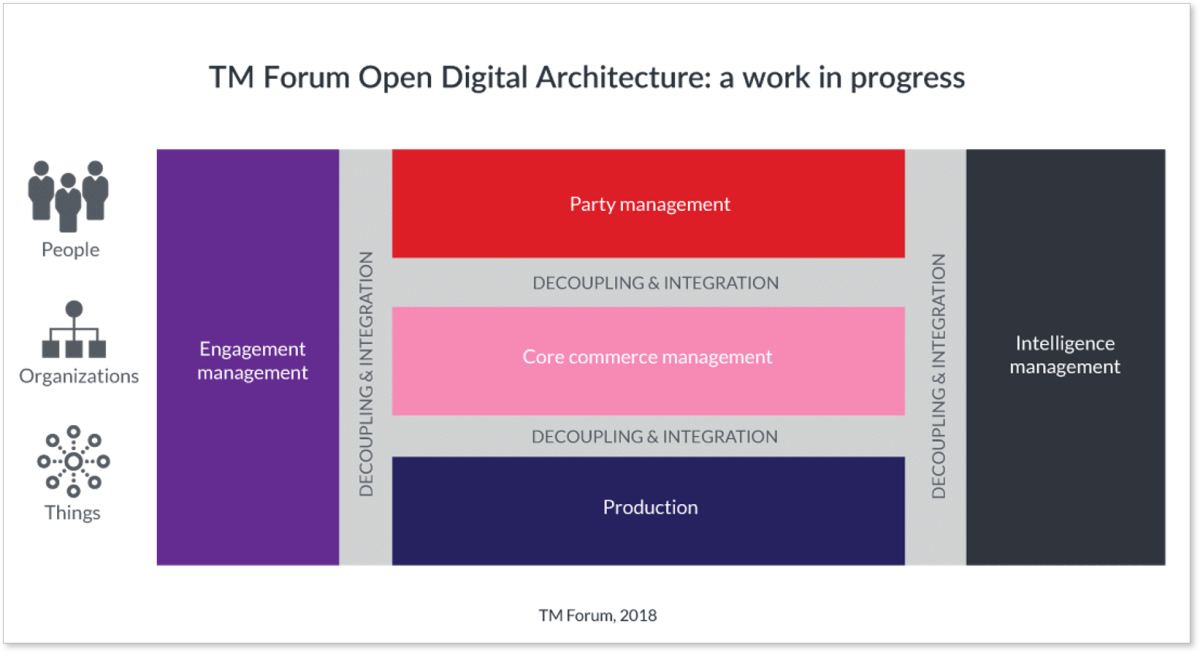This article is part 3 of a four-part series on the power of API-powered platforms to transform the telecommunications industry. Part 2 showed how platforms are transforming the Telco industry (and the role of 5G in accelerating the transformation), we now discuss efforts to standardize APIs for telcos.
So, what happens at the code level? The TM Forum has created API standardization, a very useful initiative to boost adoption and design of APIs in any industry. Telcos have always been good at creating standards (think GSM), and now we have one for APIs.
Building API standards for Telcos
TM Forum standard turned the OSS (Operational Support Systems) and BSS (Business Support Systems) standards into a set of APIs telco need to provide and interface with.

To standardize API contracts within the telco sector, the TM Forum came up with a standard in 3 tiers: production, core commerce, party management, which is very similar to the standards we generally have for APIs (internal, partner and public APIs).
All the commercial, core, or production APIs are already standardized, and telcos are working so that their system can give life to these interfaces – and it’s a journey in itself to interface with traditional and legacy IT.
The same focus of a whole industry happened with banks in Europe with PSD2. It took four years of work to get the first APIs working, leading to production in 2019 from barely knowing what an API was. So, what’s happening right now is a good example of collaboration between telcos around the world.
Telcos can leverage unique advantages to monetize APIs
Once you have these basic APIs for your system, you need to use them to create new experiences. There are six main APIs that are especially useful for monetization and revenue-driving purposes:
WebRTC APIs (real-time connection APIs), which we’ve just seen with the example of Vonage and its informational chatbots.
Messaging APIs (SMS, MMS, USSD and RCS), such as with Twilio’s COVID tracking exposure notifications.
IoT APIs. loT represents a vast and mostly untapped market for communication service providers, because it allows carriers to act as an orchestrator/mediator within the loT ecosystem.
For example, Building on TM Forum’s Open APIs, Vodafone and Axiata created an interface especially for IoT with the objective of speeding up prototyping and commercial IoT deployments, so that CSPs can expand quickly into vertical markets and commercialize.
Opening telcos to the potential of IoT with APIs paves the way for an explosion of high-value services provided by telcos leveraging the hypergrowth of AI and IoT.
Payment APIs. This is a direct carrier billing API that connects the major app stores, digital content merchants, and device manufacturers worldwide to mobile operators. The payments API is designed to provide the user with a server-to-server payment using the existing communication infrastructure and carrier billing connectivity. This kind of API is developed to provide high availability and high scale payment processing – think Stripe or Ayden.
This one is fundamental for telcos: in the developing world, many people don’t have bank accounts, so they use their telco as a bank. The first such model was Vodafone’s M-PESA in Kenya. It’s a fundamental business development opportunity and a very smart way to create new value leveraging the trust consumers have in their telco.
Orange has done a very good job capitalizing on this, launching completely mobile banking services in West Africa two years ago, where they’re offering an alternative to traditional banks’ mobile apps.
Location & Map APIs and Subscriber Identity Management and Single Sign On (SSO) APIs. Telcos are uniquely well-positioned to offer value with regards to localization and security.
Localization is a core strength for telcos: we’re all walking around with a smart device in our pockets! And security is fundamental in APIs. Telcos already have the ability to identify people in many ways, and they can create APIs to help other companies verify identity. It’s very useful, and telcos can charge for that, creating another API-based business model.
In part 4, the final article in this series, I’ll share a real-world example of one telco that leveraged APIs to create an entirely new business model, forming new partnerships and crafting better customer experiences.
Learn how leading companies are co-creating value with partners and delivering engaging experiences for customers.


